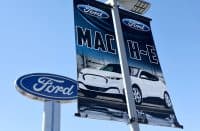In late 2005 and early 2006, GM’s (GM) stock hit multi-year lows, dropping below $20. Ford’s (F) shares also sold down on fears that both companies could face Chapter 11. Their costs were far too high and their pieces of the US market were being lost to Toyota (TM) and other competitors.
The UAW had become the worst enemy of GM. Costs of maintaining health benefits and pensions had become back-breaking for the company.
Now GM has eliminated many of those labor costs through a new UAW contract and employee buy-outs. The largest immediate problem at the US automaker is that high gas prices are driving down sales, especially those of its highly profitable SUVs and pick-ups. Rival Ford just announced that it was dropping its goal of being profitable in 2009 due to several of the same headaches.
But, the problem which has come back to haunt GM is the UAW. The company said that due to a union strike at supplier American Axle (AXL), GM "lost truck production of 230,000 vehicles in the second quarter. GM estimated that drop would lower its pretax earnings by $1.8 billion," according to The Wall Street Journal. UAW strikes against GM in Kansas will also trim earnings.
GM’s problem is that it is not primarily dealing with the UAW on a national level. The strikes hurting the company tend to be fairly small and local. But, they can still partially shut down the huge firm.
No matter what happens to GM’s revenue for the rest of 2008 and into 2009, labor problems could be the company’s single biggest challenge.
Douglas A. McIntyre
The Average American Is Losing Momentum on Their Savings Every Day (Sponsor)
If you’re like many Americans and keep your money ‘safe’ in a checking or savings account, think again. The average yield on a savings account is a paltry .4%* today. Checking accounts are even worse.
But there is good news. To win qualified customers, some accounts are paying nearly 10x the national average! That’s an incredible way to keep your money safe and earn more at the same time. Our top pick for high yield savings accounts includes other benefits as well. You can earn up to 3.80% with a Checking & Savings Account today Sign up and get up to $300 with direct deposit. No account fees. FDIC Insured.
Click here to see how much more you could be earning on your savings today. It takes just a few minutes to open an account to make your money work for you.
Thank you for reading! Have some feedback for us?
Contact the 24/7 Wall St. editorial team.




